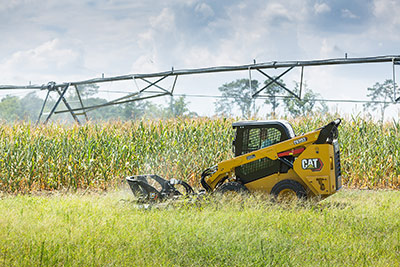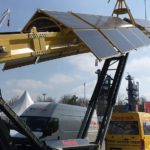Caterpillar recently released the purpose-built Cat 299D3 XE Land Management compact track loader, which is designed to handle demanding vegetation-management applications such as right-of-way clearing near power lines, brush cutting, mowing and mulching.
The machine is part of a new series of Cat D3 skid steer loader (SSL) and compact track loader (CTL) models that improve on the performance and control capabilities of the company’s previous D and D2 Series units. An industry first, the D3 Series models also support a line of new Smart attachments that tailors the controls and operator information to match the tool and task.
Ample hydraulic power

The Cat 299D3 XE Land Management CTL is the most technically advanced unit in the Cat SSL and CTL line, according to company officials. Ensuring optimum performance when powering high-production hydromechanical attachments like mowers and mulching heads, the machine features a turbocharged 110 hp (82 kW) Cat C3.8 engine that drives a 40 gpm (150 lpm) high-flow/high-pressure auxiliary hydraulic system rated at 4,061 psi (280 bar). The system produces 94 hp (70 kW) of hydraulic horsepower.
A high-flow, high-pressure system is critical in these types of applications, said Kevin Coleman, a product specialist with Caterpillar’s skid steer and compact loader group. “With a power-hungry attachment on the front, you want the performance to take that mulching head and really rip into and tear through material, and recover.” Many competing machines offer sufficient flow capacity but not necessarily the requisite pressure to handle demanding tasks, he continued. More flow permits higher speed on a rotating tool. But without sufficient system pressure that tool cannot readily cut through dense vegetation without lugging. “That combination of pressure and flow are what really helps you do that work, and do it more efficiently,” he said.
Caterpillar’s performance-matched tools take full advantage of the hydraulic capability of the machine. “We designed these two to work in concert with each other so you get maximum productivity,” said Coleman. Even beyond land clearing, jobs like cold planing, mulching and industrial sweeping demand larger tools that require more hydraulic horsepower. That’s what separates the Land Management loader from some of the other products on the market, he said.
A lot of tool manufacturers serve this market and make attachments that could fit this machine, Coleman admits. “But their engineers don’t sit next to our machine engineers. When I say it’s performance-matched, what I mean is that the engineers who are working on the attachments sit right next to the engineers that are working on the machines. We understand the hydraulic systems. We understand the designs of our machines and how those two work together.”

Competing products often require tweaks to their designs or compromises in operation or durability, he said. “Not to knock any of the other manufacturers at all, it’s just a difference in philosophy about what we believe our customers expect when they pay for a Cat attachment,” said Coleman.
Good system engineering also ensures that powering the tools does not hamper other hydraulic tasks, he continued. The machine’s controls efficiently manage all hydraulic demands and loads, whether it’s for travel, auxiliary, lift, cooling or other functions to automatically maintain a high level of overall performance.
Several pumps come into play. Mounted near the flywheel, a tandem pump in a single housing powers the hydrostatic drive. Next is a pump that supplies auxiliary systems, then another that drives the cooling fan and additional components.
The auxiliary system uses a variable-displacement piston pump, which is a real differentiator in generating the requisite pressure and flow, said Coleman. “Most machines in the market, even in this size class, will offer sufficient flow, but that is usually from a gear pump.” Gear pumps run constantly, generating heat and consuming power – in essence wasting fuel, he explained. A variable-displacement piston pump, on the other hand, can vary output to meet demand. It only operates when needed and is more efficient, he said.
Design enhancements

To provide longer intervals of uninterrupted work, the 299D3 XE Land Management has a 58.1-gallon (220 l) fuel capacity, which is 80% larger than the tank on standard 299D3 XE model and is sized to provide an estimated run time of 11 to 12 hours. A one-piece sealed and pressurized cab keeps the operator’s environment clean and quiet, which is especially important for users working long shifts in challenging conditions.
Additional seals and covers restrict debris and other materials from entering the engine compartment and lower frame, while large removable panels provide easy access to aid in routine cleaning. Extensive guarding protects undercarriage drive-line hoses, auxiliary-hydraulic quick-disconnect fittings and work-tool electrical harness connections from impact and debris hazards in land-clearing applications.
The cooling system’s hydraulically driven fan operates only when required, to save fuel, while the reversing fan feature clears intake screens of debris, so the system runs cooler when operating in high ambient temperature applications. A turbine-type precleaner ejects dust, dirt, and debris from engine-intake airflow before it reaches the filter, thus extending air-filter service life.
Smart control
Cat SSLs and CTLs offer advanced control functions that include Return-to-Dig and Work Tool Positioner, features that help operators automate repetitive tasks like grading, digging and loading, and complete them with less user interaction and expertise.
The models can also take advantage of optional Smart dozer blades, grader blades and backhoes. When using a Smart device, the host machine recognizes the attachment and unlocks special operator display screens. Selecting the attachment-control mode changes standard joystick functions (left for travel, right for boom and bucket) and allows the left joystick to continue to control travel, while the right joystick now operates attachment functions such as blade tilt, lift, and angle.
“This is a really exciting machine for us,” said Coleman. It addresses the growing-land management segment, handling applications like clearing land for vegetation management, fire breaks, right-of-ways for utilities and railroads, and oil and gas line maintenance. And while Caterpillar terms the Cat 299D3 XE Land Management CTL a purpose-built machine, it actually offers a lot of versatility, he said.
“You can take this machine out of the woods, so to speak, put a bucket on the front and grade dirt, put on a broom and sweep, or change out the tool and attach an augur. We think that this machine is going to help our customers do all that work more comfortably and more efficiently,” said Coleman.
Caterpillar
cat.com







[…] post Land-management loader packs hydraulic horsepower appeared first on Mobile Hydraulic […]